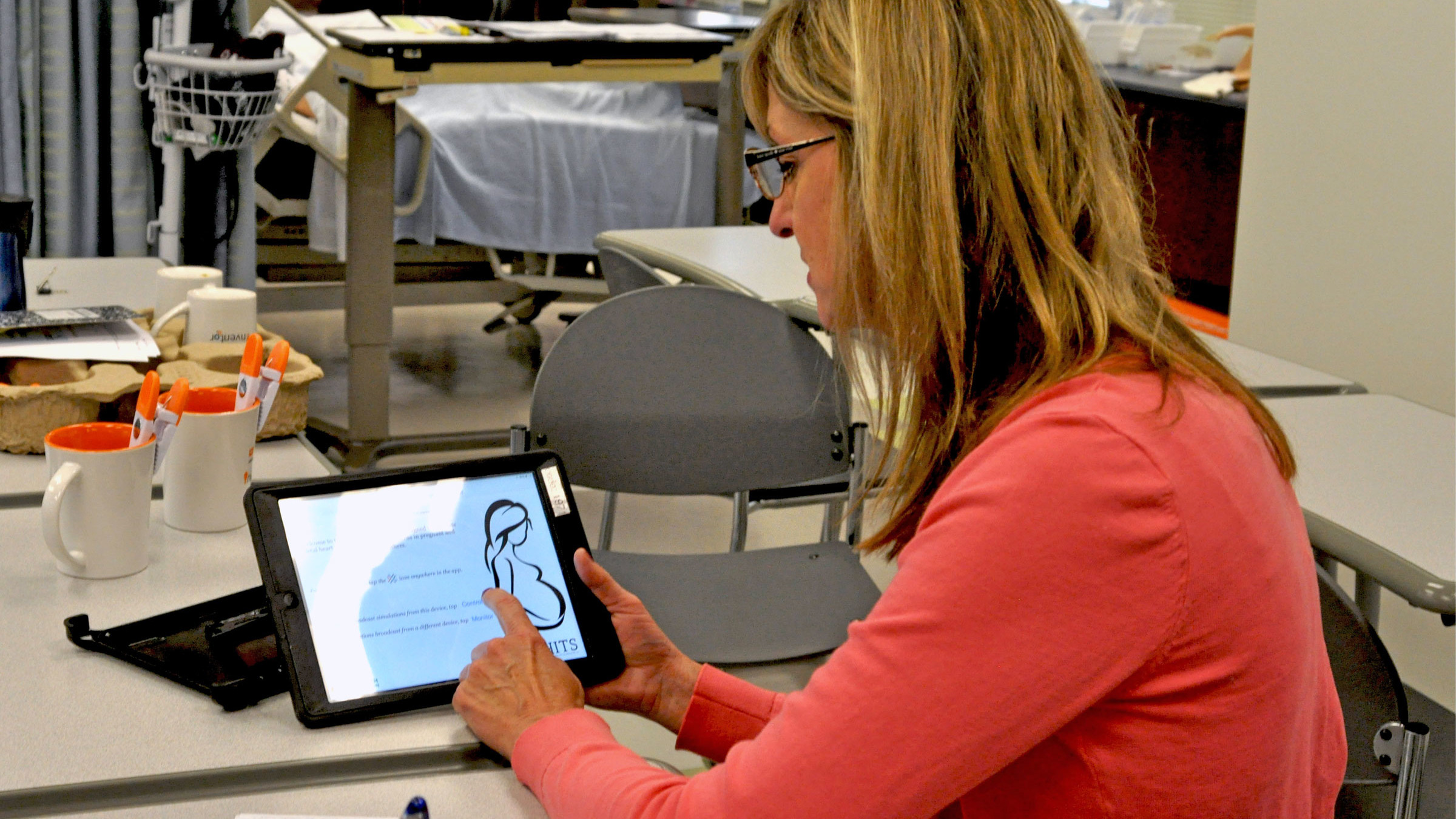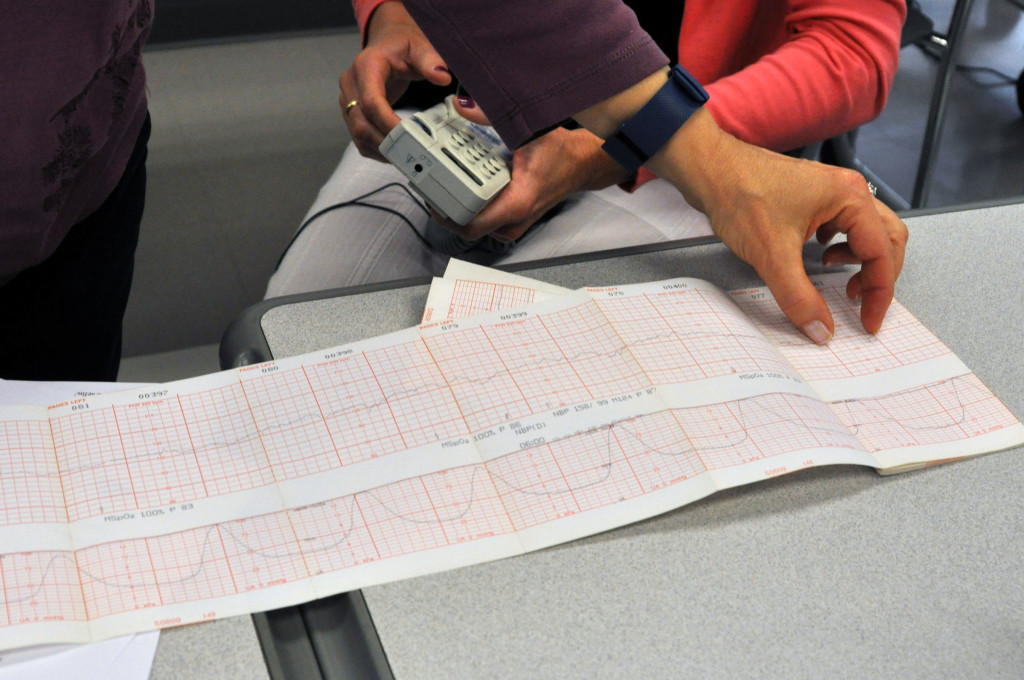
KNOXVILLE – Sheila Taylor leaned in to see the baby’s heartbeat rhythm. She watched as the baby’s heartbeat line fell without a corresponding spike showing the mother’s uterus contracting down on it.
“That looks ugly,” she murmured.
This time, though, there was no baby in distress. No quick phone call to a doctor. No hurried Caesarean delivery. It was all just a University of Tennessee iPad simulation app to train labor and delivery nurses.
Taylor, a UT clinical assistant professor in the College of Nursing, and Susan Fancher, the simulation director for the College of Nursing, worked to develop the app to create a more realistic experience to instruct future nurses in monitoring babies and their mothers during labor. Xueping Li, associate professor of industrial and systems engineering, and Tami Wyatt, professor in College of Nursing, also helped develop the app.
“We love to collaborate with others,” Fancher said. “We have problems and others can help us find solutions.”
The app mirrors the latest evolution in fetal care. Since the 19th century, nurses and doctors used a fetoscope – a combination of a listening horn and a stethoscope – to listen to a baby’s heartbeat. In the 1960s, doctors and nurses began using electronic fetal heart rate monitors to discover when a baby might run into difficulty with the birth. Fetal monitors used to print out the birthing rhythms, showing the valleys and peaks of the baby’s heartbeat and the mother’s contraction levels on continuous strips of five-inch wide paper. Now, U.S. hospitals have put more than 28,000 monitors to work and banks of computer screens show continuous scrolls of the rhythms, 10-second life increments between mother and infant.
And there’s a need for nurses to interpret the data to assess the baby’s health. If nurses spot problems such as the baby’s heartrate falling when the mother isn’t having a contraction, they call the healthcare provider.
“The nurse is the expert in the room for fetal heart tracing,” Fancher said.

For years, nurses in training practiced reading signs in the paper strips. The app gives nursing students a simulation on iPads that mirrors the real world. Instructors can set the baby’s heart rate, how often the contractions happen and various alterations that in real life could spell trouble for the baby. They can broadcast via the iPads that simulation to all of their students, who then practice interpreting the signs during the wonder of childbirth.
“We play with this for three hours,” Taylor said. “They know fetal monitoring when we’re through.”
Students also can download the app to practice interpreting the data on their own.
While the UT nursing simulation lab is filled with lifelike simulator mannequins that allow students to practice, it has only one birthing mother. The $55,000 mannequin price tag is a steep difference from the $5 mobile app for students and $25 for instructor cost.
And it makes a difference with the students, as well. After conducting trials with the app during the summer of 2014, the professors, with the help of the UT Research Foundation, released it in 2015 and began using it in their classrooms.
Abbey Taylor and Alisa Melnikova, nursing students who will graduate in May and have accepted positions with UT Medical Center in Knoxville as labor and delivery nurses, said the app matched the real-world experience.
“The whole point of simulation is to be the most realistic exposure that it can be,” said Melnikova. “The simulations at the College of Nursing have been well-done.”
When Abbey Taylor arrived at her field experience hospital, she watched the fetal heart monitors sending the updates at 10-second intervals and her nerves quieted.
“It was like, ‘Oh, I’ve seen that,’” she said with a laugh. “It helped a lot to be prepared for that.”
Now, with the help of the UT Research Foundation, more students across the nation and world can learn through the app. Since its release, the student version of the app has been downloaded more than 100 times and the instructor more than a dozen.
Patrick Reynolds, Research Foundation licensing associate, said the professors contacted him early in their design process so they “could figure out the best strategy for the app release.” The Research Foundation staff works with University faculty to license and patent their inventions. They worked with Sheila Taylor and Fancher to get the simulation available on the app store and to market it.
“UTRF has been crucial to us to get it out there,” Fancher said.
But the team hasn’t finished with its design. They are working on a sound upgrade to mimic the swhoosh-swhoosh of a baby’s heartbeat heard through an actual monitor. They see great potential for the app as labor and delivery nurses must test for a certificate in fetal monitoring and document their competency in it each year.
“I think it will stay in the academic setting and migrate to the business setting,” Sheila Taylor said.
The University of Tennessee is a statewide system of higher education with campuses in Knoxville, Chattanooga, Martin and Memphis; the UT Space Institute in Tullahoma; the UT Institute of Agriculture with a presence in every Tennessee county; and the statewide Institute for Public Service. The UT system manages Oak Ridge National Laboratory through its UT-Battelle partnership; enrolls about 50,000 students statewide; produces about 10,000 new graduates every year; and represents more than 360,000 alumni around the world.
UTRF is a non-profit 501(c)(3) organization that promotes the commercialization of UT intellectual property, encourages an entrepreneurial culture, contributes to state and regional economic development, and promotes research and education to benefit the people of Tennessee and beyond. For more information, visit utrf.tennessee.edu.
Contacts
Jennifer Sickingjsicking@tennessee.edu
865-974-5179
Melissa Dos Santos
mdossant@utk.edu
865-974-1809
